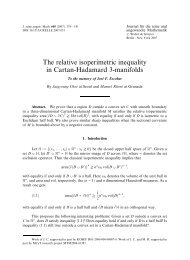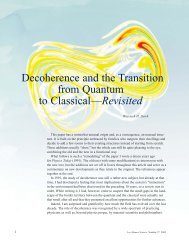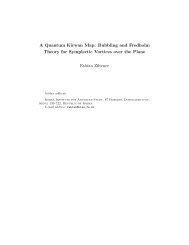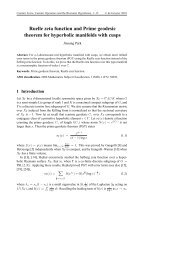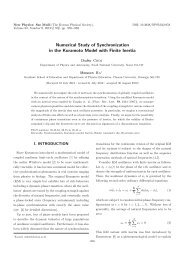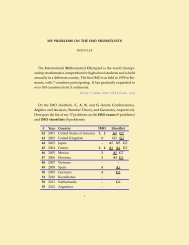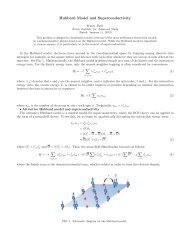Holographic Entanglement Entropy - KIAS
Holographic Entanglement Entropy - KIAS
Holographic Entanglement Entropy - KIAS
Create successful ePaper yourself
Turn your PDF publications into a flip-book with our unique Google optimized e-Paper software.
<strong>Holographic</strong><br />
<strong>Entanglement</strong> <strong>Entropy</strong><br />
(with H. Casini, M. Huerta, J. Hung, A. Sinha, M. Smolkin & A. Yale)<br />
(arXiv:1101.5813, arXiv:1102.0440, arXiv:1109.0 )
<strong>Entanglement</strong> <strong>Entropy</strong><br />
• what is entanglement entropy<br />
very general tool; divide quantum system into two parts and<br />
use entropy as measure of correlations between subsystems<br />
• in QFT, typically introduce a (smooth) boundary or entangling<br />
surface which divides the space into two separate regions<br />
• integrate out degrees of freedom in “outside” region<br />
• remaining dof are described by a density matrix<br />
calculate von Neumann entropy:<br />
A<br />
B
<strong>Entanglement</strong> <strong>Entropy</strong><br />
• remaining dof are described by a density matrix<br />
calculate von Neumann entropy:<br />
A<br />
R<br />
B<br />
• result is UV divergent! leading terms sensitive to regulator:<br />
= spacetime dimension<br />
= short-distance cut-off<br />
• find universal information characterizing underlying QFT in<br />
subleading terms, e.g.:
<strong>Entanglement</strong> <strong>Entropy</strong><br />
• remaining dof are described by a density matrix<br />
calculate von Neumann entropy:<br />
• nonlocal quantity which is (at best) very difficult to measure<br />
• in condensed matter theory: diagnostic to characterize quantum<br />
critical points or topological phases (eg, quantum hall fluids)<br />
• in quantum information theory: useful measure of quantum<br />
entanglement (a computational resource)<br />
• in black hole physics: leading term obeys “area law”<br />
reminiscent of black hole entropy (eg, )<br />
(Bombelli, Koul, Lee & Sorkin; Srednicki; Frolov; Callan & Wilczek; Susskind; . . . . )<br />
• recently considered in AdS/CFT correspondence<br />
(Ryu & Takayanagi `06)
<strong>Holographic</strong> <strong>Entanglement</strong> <strong>Entropy</strong>:<br />
(Ryu & Takayanagi `06)<br />
AdS boundary<br />
A<br />
B<br />
boundary<br />
conformal field<br />
theory<br />
AdS bulk<br />
spacetime<br />
gravitational<br />
potential/redshift<br />
• “UV divergence” because area integral extends to<br />
technicalities<br />
looks like<br />
BH entropy!
<strong>Holographic</strong> <strong>Entanglement</strong> <strong>Entropy</strong>:<br />
(Ryu & Takayanagi `06)<br />
AdS boundary<br />
A<br />
B<br />
cut-off:<br />
cut-off surface<br />
• “UV divergence” because area integral extends to<br />
• finite central result charge by stopping radial integral at large radius:<br />
(counts short-distance dof) cut-off in boundary theory: “Area Law”
<strong>Holographic</strong> <strong>Entanglement</strong> <strong>Entropy</strong>:<br />
(Ryu & Takayanagi `06)<br />
AdS boundary<br />
A<br />
B<br />
cut-off:<br />
cut-off surface<br />
general expression (as desired):<br />
(d even)<br />
universal contributions<br />
(d odd)
<strong>Holographic</strong> <strong>Entanglement</strong> <strong>Entropy</strong>:<br />
(Ryu & Takayanagi `06)<br />
conjecture<br />
Extensive consistency tests:<br />
1) leading contribution yields “area law”<br />
2) recover known results of Calabrese & Cardy<br />
for d=2 CFT<br />
(also result for thermal ensemble)
<strong>Holographic</strong> <strong>Entanglement</strong> <strong>Entropy</strong>:<br />
(Ryu & Takayanagi `06)<br />
conjecture<br />
Extensive consistency tests:<br />
1) leading contribution yields “area law”<br />
2) recover known results of Calabrese & Cardy<br />
for d=2 CFT<br />
(also result for thermal ensemble)<br />
3) in a pure state<br />
AdS<br />
boundary<br />
and both yield same bulk surface V<br />
(not pure state horizon in bulk; for thermal state)
<strong>Holographic</strong> <strong>Entanglement</strong> <strong>Entropy</strong>:<br />
(Ryu & Takayanagi `06)<br />
conjecture<br />
Extensive consistency tests:<br />
4) <strong>Entropy</strong> of eternal black hole =<br />
entanglement entropy of boundary CFT & thermofield double<br />
(Headrick)<br />
thermofield<br />
double<br />
boundary<br />
CFT<br />
extremal surface =<br />
bifurcation surface
<strong>Holographic</strong> <strong>Entanglement</strong> <strong>Entropy</strong>:<br />
(Ryu & Takayanagi `06)<br />
conjecture<br />
Extensive consistency tests:<br />
4) <strong>Entropy</strong> of eternal black hole =<br />
entanglement entropy of boundary CFT & thermofield double<br />
(Headrick)<br />
5) sub-additivity:<br />
(Headrick & Takayanagi)<br />
[ “all” other inequalities: Hayden, Headrick & Maloney]
<strong>Holographic</strong> <strong>Entanglement</strong> <strong>Entropy</strong>:<br />
(Ryu & Takayanagi `06)<br />
conjecture<br />
Extensive consistency tests:<br />
4) <strong>Entropy</strong> of eternal black hole =<br />
entanglement entropy of boundary CFT & thermofield double<br />
(Headrick)<br />
5) sub-additivity:<br />
(Headrick & Takayanagi)<br />
6) for general even d, connection to central charges of CFT<br />
(Hung, RCM & Smolkin, arXiv:1101.5813)<br />
7) derivation of holographic EE for spherical entangling surfaces<br />
(Casini, Huerta & RCM, arXiv:1102.044)<br />
(see also: RCM & Sinha, arXiv:1011.5819)
Central charges and trace anomaly:<br />
d=2:<br />
c<br />
d=4:<br />
c<br />
a<br />
and<br />
• in higher (even) dimensions, number of central charges grows<br />
B<br />
(Deser & Schwimmer)<br />
• universal contribution to entanglement entropy determined<br />
using trace anomaly (for even d)<br />
(Holzhey, Larsen & Wilczek;Calabrese & Cardy;Takayanagi & Ryu;Schwimmer & Theisen)<br />
A<br />
(RCM & Sinha)<br />
• partial result! needs rotational symmetry on entangling surface Σ
Central charges and trace anomaly:<br />
d=2:<br />
c<br />
d=4:<br />
c<br />
a<br />
and<br />
• in higher (even) dimensions, numbers of central charges grows<br />
• universal contribution to entanglement entropy determined<br />
using trace anomaly (for even d)<br />
d=4:<br />
d=2:<br />
c<br />
c<br />
(Holzhey, Larsen & Wilczek;<br />
Calabrese & Cardy)<br />
a<br />
corrections for general (smooth) Σ<br />
(Solodukhin)
Central charges and trace anomaly:<br />
d=2:<br />
c<br />
d=4:<br />
c<br />
a<br />
and<br />
• in higher dimensions, numbers of central charges grows<br />
• universal contribution to entanglement entropy determined<br />
using trace anomaly (for even d)<br />
• central charges identified in AdS/CFT using holographic<br />
trace anomaly:<br />
e.g., for (boundary) d=4:<br />
• for general d, central charges<br />
• for Einstein gravity, all central charges equal for any d<br />
(Henningson &Skenderis)<br />
• distinguishing central charges requires higher curvature gravity
<strong>Holographic</strong> <strong>Entanglement</strong> <strong>Entropy</strong>:<br />
• consider more general gravity theory in AdS:<br />
(Hung, Myers & Smolkin)<br />
• how do we evaluate holographic entanglement entropy<br />
take direction from tests of R&T prescription
<strong>Holographic</strong> <strong>Entanglement</strong> <strong>Entropy</strong>:<br />
(Ryu & Takayanagi `06)<br />
conjecture<br />
Extensive consistency tests:<br />
4) <strong>Entropy</strong> of eternal black hole =<br />
entanglement entropy of boundary CFT & thermofield double<br />
(Headrick)<br />
5) sub-additivity:<br />
(Headrick & Takayanagi)<br />
[other inequalities: Hayden, Headrick & Maloney]
<strong>Holographic</strong> <strong>Entanglement</strong> <strong>Entropy</strong>:<br />
• consider more general gravity theory in AdS:<br />
(Hung, Myers & Smolkin)<br />
• natural conjecture: extremize Wald’s entropy formula<br />
• focus on universal term for d=4:<br />
c<br />
(Solodukhin)<br />
a<br />
• holographic calculation following above conjecture yields<br />
a<br />
a<br />
conjecture wrong
<strong>Holographic</strong> <strong>Entanglement</strong> <strong>Entropy</strong>:<br />
• consider more general gravity theory in AdS:<br />
(Hung, Myers & Smolkin)<br />
• natural conjecture: extremize Wald’s entropy formula<br />
• holographic calculation following above conjecture yields<br />
a<br />
a<br />
• triumph of R&T prescription in Einstein gravity!! (c = a)<br />
• for general gravity action, conjecture is wrong<br />
• there is nothing wrong with Wald’s formula!!<br />
to proceed further, focus on special gravity actions
<strong>Holographic</strong> <strong>Entanglement</strong> <strong>Entropy</strong>:<br />
• consider special case of Gauss-Bonnet gravity:<br />
(Hung, Myers & Smolkin)<br />
• studied in detail for stringy gravity in 1980’s<br />
4d Euler density<br />
• higher curvature but eom are still second order!!<br />
(Lovelock)<br />
(Zwiebach; Boulware & Deser; Wheeler; Myers & Simon; . . . .)<br />
• interest recently in AdS/CFT studies – a toy model with<br />
(eg, Brigante, Liu, Myers, Shenker,Yaida, de Boer, Kulaxizi, Parnachev, Camanho,<br />
Edelstein, Buchel, Sinha, Paulos, Escobedo, Smolkin, Cremonini, Hofman, . . . .)<br />
• black hole entropy:<br />
(Jacobson & Myers)<br />
• not precisely same as Wald entropy – agree when<br />
vanish
<strong>Holographic</strong> <strong>Entanglement</strong> <strong>Entropy</strong>:<br />
• consider special case of Gauss-Bonnet gravity:<br />
(Hung, Myers & Smolkin)<br />
(deBoer, Kulaxizi & Parnachev)<br />
4d Euler density<br />
• second conjecture: extremize JM entropy formula<br />
• again consider universal term for d=4:<br />
c<br />
(Solodukhin)<br />
a<br />
• holographic calculation following above conjecture yields<br />
c<br />
a<br />
passes nontrivial test
<strong>Holographic</strong> <strong>Entanglement</strong> <strong>Entropy</strong>:<br />
• consider special case of Gauss-Bonnet gravity:<br />
(Hung, Myers & Smolkin)<br />
(deBoer, Kulaxizi & Parnachev)<br />
4d Euler density<br />
• second conjecture: extremize JM entropy formula<br />
reproduces universal term for any smooth surface in d=4<br />
partial results for d=6 (geometries with rotational symmetry;<br />
found new curvature corrections when )<br />
extends to general Lovelock theories for d≥6<br />
still no general result for completely general gravity action <br />
with sufficient symmetry, Wald entropy seems correct<br />
curious instability to adding handles for (Ogawa & Takayanagi)
<strong>Holographic</strong> <strong>Entanglement</strong> <strong>Entropy</strong>:<br />
(Ryu & Takayanagi `06)<br />
conjecture<br />
Extensive consistency tests:<br />
4) <strong>Entropy</strong> of eternal black hole =<br />
entanglement entropy of boundary CFT & thermofield double<br />
(Headrick)<br />
5) strong subadditivity:<br />
(Headrick & Takayanagi)<br />
6) for general even d, connection to central charges of CFT<br />
(Hung, RCM & Smolkin, arXiv:1101.5813)<br />
7) derivation of holographic EE for spherical entangling surfaces<br />
(Casini, Huerta & RCM, arXiv:1102.044)<br />
(see also: RCM & Sinha, arXiv:1011.5819)
Calculating <strong>Entanglement</strong> <strong>Entropy</strong>:<br />
• “standard” approach relies on replica trick and calculating Renyi<br />
entropy first and taking n 1 limit<br />
• replica trick involves path integral of QFT in singular n-fold cover<br />
of background spacetime<br />
• problematic in holographic framework<br />
produce singularity in dual gravity description<br />
(resolved by quantum gravity/string theory)<br />
(Fursaev; Headrick)<br />
• need another calculation with simpler holographic translation
Calculating <strong>Entanglement</strong> <strong>Entropy</strong>:<br />
• take CFT in d-dim. flat space and choose<br />
entanglement entropy:<br />
(Casini, Huerta & RCM)<br />
with radius R<br />
A<br />
B<br />
• density matrix<br />
describes physics in entire causal domain<br />
• conformal mapping:
General result for any CFT<br />
(Casini, Huerta & RCM)<br />
• take CFT in d-dim. flat space and choose S d-2 with radius R<br />
entanglement entropy:<br />
A<br />
• conformal mapping:<br />
• for CFT:<br />
curvature scale: 1/R temperature: T=1/2πR !!
General result for any CFT<br />
(Casini, Huerta & RCM)<br />
• take CFT in d-dim. flat space and choose S d-2 with radius R<br />
entanglement entropy:<br />
by conformal mapping relate to thermal entropy<br />
on<br />
with R ~ 1/R 2 and T=1/2πR<br />
AdS/CFT correspondence:<br />
• thermal bath in CFT = black hole in AdS<br />
• only need to find appropriate black hole<br />
topological BH with hyperbolic horizon<br />
which intersects A on AdS boundary<br />
(Aminneborg et al; Emparan; Mann; . . . )<br />
A
• desired “black hole” is a hyperbolic foliation of empty AdS space<br />
• “Rindler coordinates” of AdS space
• desired “black hole” is a hyperbolic foliation of empty AdS space<br />
• apply Wald’s formula (for any gravity theory) for horizon entropy:<br />
(RCM & Sinha)<br />
where<br />
= central charge for “A-type trace anomaly”<br />
for even d<br />
= entanglement entropy defines effective central charge<br />
for odd d
• desired “black hole” is a hyperbolic foliation of empty AdS space<br />
• apply Wald’s formula (for any gravity theory) for horizon entropy:<br />
intersection with standard<br />
regulator surface:<br />
“area law” for d-dimensional CFT<br />
A
• desired “black hole” is a hyperbolic foliation of empty AdS space<br />
• apply Wald’s formula (for any gravity theory) for horizon entropy:<br />
universal contributions:<br />
for even d<br />
for odd d<br />
• discussion extends to case with background:
<strong>Holographic</strong> Renyi entropy:<br />
(Hung, RCM, Smolkin & Yale)<br />
• turn to Renyi entropy (close cousin of entanglement entropy)<br />
• universal contribution (for even d)
<strong>Holographic</strong> Renyi entropy:<br />
(Hung, RCM, Smolkin & Yale)<br />
• turn to Renyi entropy (close cousin of entanglement entropy)<br />
• universal contribution (for even d)<br />
d=2:<br />
(Calabrese & Cardy)<br />
• (almost) no calculations for d > 2
<strong>Holographic</strong> Renyi entropy:<br />
(Hung, RCM, Smolkin & Yale)<br />
• turn to Renyi entropy (close cousin of entanglement entropy)<br />
• “standard” calculation involves singular n-fold cover of spacetime<br />
problematic for translation to dual AdS gravity<br />
• our previous derivation lead to thermal density matrix<br />
with<br />
partition function at new<br />
temperature,
<strong>Holographic</strong> Renyi entropy:<br />
(Hung, RCM, Smolkin & Yale)<br />
• turn to Renyi entropy (close cousin of entanglement entropy)<br />
• “standard” calculation involves singular n-fold cover of spacetime<br />
problematic for translation to dual AdS gravity<br />
• with bit more work, find convenient formula:<br />
where<br />
Renyi entropy<br />
for spherical Σ<br />
thermal entropy<br />
on hyperbolic space H d-1<br />
• in holographic framework, need to know topological black hole<br />
solutions for arbitrary temperature
<strong>Holographic</strong> Renyi entropy:<br />
(Hung, RCM, Smolkin & Yale)<br />
• Renyi entropy of CFT for spherical entangling surface:<br />
where<br />
• need to know topological black holes for arbitrary temperature<br />
• focus on gravity theories where we can calculate: Einstein,<br />
Gauss-Bonnet, Lovelock, quasi-topological, …..<br />
• for example, with GB gravity and (boundary) d=4:<br />
where<br />
• further work shows the universal constant depends on more<br />
data about the boundary CFT than central charges alone
General Lessons/Challenges:<br />
• is there a “covariant” definition of holographic EE<br />
(“covariant” = in terms of light sheets & causal structure)<br />
A<br />
(see, eg, Hubney, Rangamani & Takayanagi)<br />
boundary of<br />
causal domain<br />
extremal<br />
surface<br />
• differences in S EE are<br />
infinite as<br />
• seems answer is: NO<br />
extremal<br />
surface for<br />
GB gravity<br />
• all three surfaces coincide for spherical Σ<br />
Problem: in general, entanglement H is nonlocal<br />
Points to new feature of QG but what are the general rules
Conclusions:<br />
• AdS/CFT correspondence (gauge/gravity duality) has proven<br />
an excellent tool to study strongly coupled gauge theories<br />
• holographic entanglement entropy is part of an interesting<br />
dialogue has opened between string theorists and physicists<br />
in a variety of fields (eg, condensed matter, nuclear physics, . . .)<br />
• potential to learn lessons about issues in boundary theory<br />
eg, readily calculate Renyi entropies for wide class<br />
of theories in higher dimensions<br />
• potential to learn lessons about issues in bulk gravity theory<br />
eg, holographic entanglement entropy may give new<br />
insight into quantum gravity or emergent spacetime<br />
Lots to explore!<br />
(eg, van Raamsdonk)
[ Extra Slides ]
AdS/CFT Dictionary:<br />
Boundary: thermal plasma<br />
Bulk: black hole<br />
Temperature<br />
Energy<br />
<strong>Entropy</strong><br />
Temperature<br />
Energy<br />
<strong>Entropy</strong>
AdS/CFT Correspondence:<br />
Bulk: gravity with negative Λ<br />
in d+1 dimensions<br />
anti-de Sitter<br />
space<br />
“holography”<br />
Boundary: quantum field theory<br />
in d dimensions<br />
conformal<br />
field theory
Lessons for bulk gravity theory:<br />
(entanglement entropy) boundary<br />
= (entropy associated with extremal surface) bulk<br />
<strong>Entropy</strong> of what<br />
not black hole, not horizon,<br />
not causal domain<br />
What are the rules<br />
extremal<br />
surface<br />
(see, eg, Hubney, Rangamani & Takayanagi)
A<br />
B
Calculating <strong>Entanglement</strong> <strong>Entropy</strong>:<br />
• consider powers of density matrix<br />
• introduce path integral representation of<br />
ground state wave-function<br />
• sew path integrals together along<br />
except in region A to produce<br />
using “replica trick”



